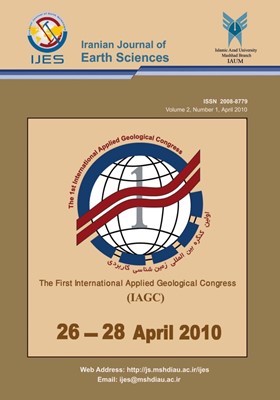CO2-H2O, Highly Saline and Carbonic Fluids from the Mesozoic Mashhad Granitoids, NE Iran
Subject Areas : MineralogyC. Srikantappa 1 , M. R. Kalantari 2 , M. N. Malathi 3
1 - Department of Geology, University of Mysore, Manasagangotri, Mysore 570 006, India
2 - Department of Geology, Payamenoor University, Iran
3 - Department of Mines and Geology, Govt. of Karnataka, Chamarajnagar, 571 313, India.
Keywords:
Abstract :
The Mesozoic Mashhad granitoid plutons have intruded into ophiolite complexes, meta-sediments and pyroclastics in the Binalood region, located SW of Mashad city in the NE part of Iran. Based on petrography and geochemistry, the Mashhad granitoids have been classified into 1) grey granite, 2) pink granite, 3) muscovite granite, 4) granodiorite and 5) pegmatite and quartz veins. Granitoids show typical igneous micro-textures with the mineral assemblage of quartz, plagioclase, K-feldspar, biotite, muscovie, amphiboles, clinopyroxene and garnet. Based on two-feldspar thermometry and hornblende-plagioclase thermometry / barometry, igneous temperatures of 750 to 770oC and pressures of 4.6 to 5.5 kbars for the emplacement of granitoids have been estimated. The granitoids of Mashhad area have been classified as moderately peraluminous, S to I type granitoids of sub-alkaline to calcic type. Fluid inclusion study on Mashhad granitoids shows the presence of Isolated Fluid Inclusions (IFI) as well as Trail Bound Inclusions (TBI). Four types of fluid inclusions viz., Type I CO2-H2O inclusions, Type II Low salinity aqueous inclusions, Type III, high salinity inclusions and Type IV Carbonic inclusions have been recorded in Mashhad granitoids. Fluid inclusions occur as rounded, oval and negative crystal shape varying in size from 5 to 16 μm. CO2-H2O fluids are the most common fluids in Mashhad granitoids. CO2 in CO2-H2O inclusions varies from 20 to 80 percent. Minor bi-phase, low salinity aqueous inclusions occur. Presence of Type III, Halite bearing fluids are found mainly in quartz veins in granodiorite. Type IV, carbonic fluids occur along late fractures which cross-cut the early Type I, CO2-H2O fluids. CO2 in CO2-H2O inclusions shows Tm around -56.8 oC, indicating almost pure carbonic inclusions. TmClath vary from 4 to 8oC. Th of CO2 in liquid phase ranges from - 9 to 22o C with densities of 0.92 to 0.68 g/cc and the total homogenization of CO2-H2O ranges from 205 to 320oC, indicating XCO2 valuesof 0.75 to 0.20 mole fraction. The bi-phase fluid inclusions show low salinity values of 4 to 8 wt. % NaCl equivalent to 1.03 to 0.96 g/cc. Type-IV, late carbonic inclusions show Th ranging from 20 to 25°C with densities from 0.82 to 0.78 g/cc. Tye III, halite bearing fluids show temperatures of melting from 315 to 335oC with salinity values of 38 to 40 wt. % NaCl equivalent. The density data of fluids in Mashhad granitoids indicates entrapment temperatures of 590 to 650oC at pressures of 4.1 to 5.2 Kbar. This data nearly coincides with the mineral P-T estimates. There are strong evidences of “fluid-present” partial melting process during the formation of S-type and I-type granitoids in Mashhad area. The low density carbonic fluids are chronologicaly late fluids trapped in granitoids, formed due to the peferential leakage of water from the early CO2-H2O inclusions. Fluid leakage is related to ductile shear deformation along thrust zones in Mashhad granitoids.


